Contents
What is Transverse reinforcement? Different types of reinforcement in columns?
The transverse reinforcement is also called as lateral ties. In the column design lateral ties are more important which are placed perpendicular to the main steel bars. The lateral ties in the column section are used to resist the bucking of the column section under various loading conditions.
The column section carries two types of the loads mainly related to the gravity loads and lateral loads. The loads related to the dead load, live load and floor loads are comes under the gravity loading conditions and the loads related to the seismic loading condition and wind loading condition and comes under lateral loads. Mainly the bucking is observed in column section due to the gravity loads. So in order to prevent the buckling of the column we have to give proper reinforcement from start to end.
Types of arrangement of reinforcement in the columns
The basic arrangement of lateral ties reinforcement in the columns is classified in to following eight types. The arrangement of reinforcement is mainly depends upon the length, width and number of main bars using in the column design.
Type 1: let us consider a column which is having length value is less than 100mm (<100mm), width value is less than 100mm (<100mm), and 4 numbers of main bars from start to end of the column. For this category the transverse reinforcement is provided with one regular single reinforced strip for the 4 bars which is shown in the below figure.

Type 2: let us consider a column which is having length value is less than 150mm (<150mm), width value is less than 150mm (<150mm), and 6 numbers of main bars from start to end of the column. For this category the transverse reinforcement is provided with one regular single reinforced strip for the 6 bars which is shown in the below figure.

Type 3: let us consider a column which is having length value is greater than 150mm (>150mm), width value is greater than 150mm (>150mm), and 6 numbers of main bars from start to end of the column. For this category the transverse reinforcement is provided with one regular single reinforced strip and one link is provided for the middle bars which is shown in the below figure.
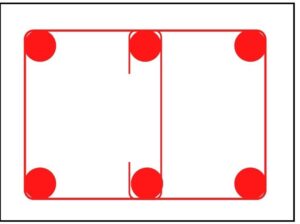
For this category if the link is not available then we can make it to two regular strips. One strip is provided for the four bars at the left hand side and another strip is provided for the four bars at the right hand side which is shown in the below figure.
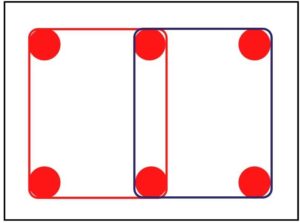
Type 4: let us consider a column which is having length value is greater than 150mm (>150mm), width value is less than 150mm (<150mm), and 6 numbers of main bars from start to end of the column. For this category the transverse reinforcement is provided with two regular single reinforced strips One strip is provided for the four bars at the left hand side and another strip is provided for the four bars at the right hand side which is shown in the below figure.
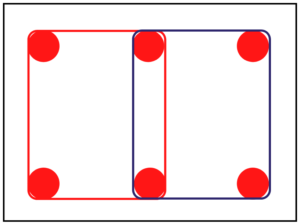
Type 5: let us consider a column which is having length value is greater than 150mm (>150mm), width value is greater than 150mm (>150mm), and 8 numbers of main bars from start to end of the column. For this category the transverse reinforcement is provided with one regular single reinforced strips and two link bars one link bar is provided from top to bottom center bars and another one is provided for the left to right for the center bars which is shown in the below figure.
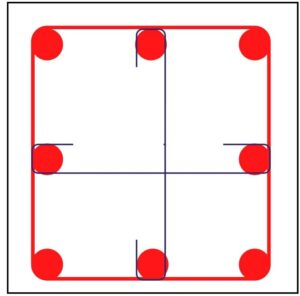
Type 6: let us consider a column which is having length value is greater than 150mm (>150mm), width value is greater than 150mm (>150mm), and 8 numbers of main bars from start to end of the column. For this category the transverse reinforcement is provided with two regular single reinforced strips one strip is provided for the four bars at the corner sides and another strip is provided for the middle bars this strip is provided in diagonal strip section which is shown in the below figure.

Type 7: let us consider a column which is having length value is greater than 225mm (>225mm), width value is less than 150mm (<150mm), and 10 numbers of main bars from start to end of the column. For this category the transverse reinforcement is provided with three regular single reinforced strips one strip is provided for the top four bars and middle two bars, another strip is provided for the bottom four bars and middle two bars, and the last strip is provided for the middle section 4 bars the complete details are shown in the below figure.
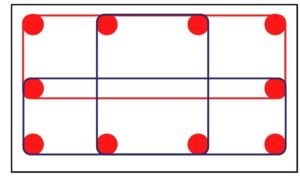
Type 8: let us consider a column which is having length value is greater than 225mm (>150mm), width value is greater than 150mm (>150mm), and 10 numbers of main bars from start to end of the column. For this category the transverse reinforcement is provided with two regular single reinforced strips and one hexagonal type one strip is provided for the corner four bars in the column section, another strip is provided for the center 4 bars and finally hexagonal strip is provided for the column with four center bars, left middle bar and right middle bar, the complete details are shown in the below figure.

The complete concepts of arrangement of transverse reinforcement is shown in my YouTube channel please see below
Conclusions of what is transverses reinforcement, arrangement of transverse reinforcement in columns
Well now the above explained concepts are related to the ties reinforcement in column. This is also called as lateral ties. This will be depends upon the length, width and number of bars in RCC rectangular column. Sometimes we will take the single reinforced strip and sometimes we can use two strips, links etc,
Please follow our previous posts here
What is crack in building? Types of cracks and prevention methods of cracks.
How to calculate number of stair cases and volume of concrete in stair for building structure.
Isolated footing design as per IS 456-2000 code
What are the load combinations used in building design as per IS 456-2000 code
What is cost estimation ? methods of cost estimation ?process of cot estimation ?
Please watch interesting concepts in my YouTube channel Civil engineering by shravan. Please feel free to text us at contact us page for any quarries.
Thank You
Your Shravan
Have a good day.